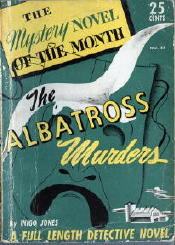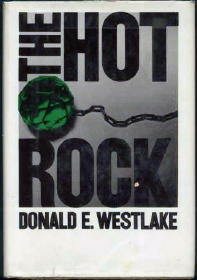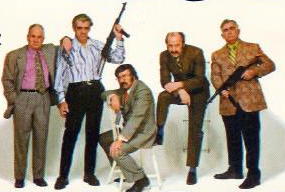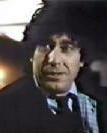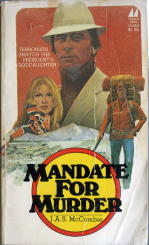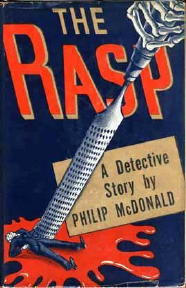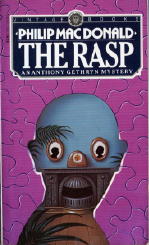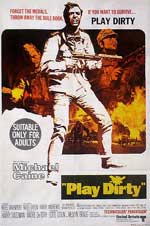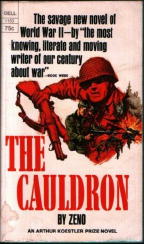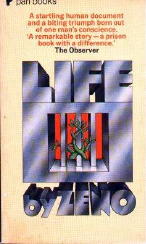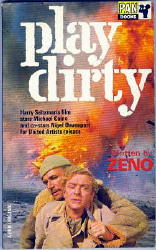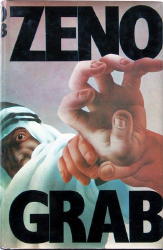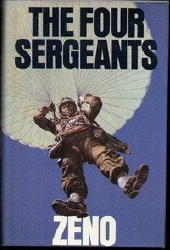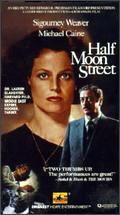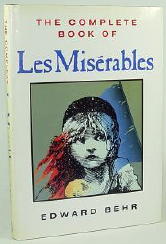June 2007
Monthly Archive
Thu 7 Jun 2007
INIGO JONES – The Albatross Murders
The Mystery Novel of the Month #33; digest-sized paperback reprint, 1941. Hardcover First Edition: Mystery House, 1941.
Beginning with what’s known so far about the author, here’s a quote from Bill Deeck’s long-awaited reference book on lending library mystery publishers, Murder at 3 Cents a Day (Battered Silicon Dispatch Box):
According to a Mystery House advertisement for
The Albatross Murders, Inigo Jones is the pseudonym of a “writer of established literary reputation, one of whose short stories is included in
Fifty Best Stories of the Last 25 Years, edited by Edward J. O’Brien.”
Some detective work is therefore in order. The actual title of the book appears to be 50 Best American Short Stories 1915-1939, and one can find a complete list of the contents on the Internet, including all fifty authors.
This narrows it down, but not enough, unless authors like Erskine Caldwell, J. P. Marquand, and Dorothy Parker can be eliminated, and they probably can. But there are enough unfamiliar names there (Robert Whitehand, I. V. Morris, Lovell Thompson and a host of similar others) that at the moment, I cannot tell you that I have proceeded any further than this.
While I am presuming that the first name Inigo denotes someone of the masculine gender (about which see below), it cannot obviously be presumed that the person behind the pseudonym is equally masculine.
If by chance it is a clue to you (but not to me) that there are two Inigo Jones’s listed online at the wikipedia website, let me know. The first is considered the first significant English architect (1573-1652), while the second is a descendant of the first, one Inigo Owen Jones (1872-1954), who is noted as having been a well-known meteorologist and long-range weather forecaster.
More clues may arise from the settings of Inigo Jones, the detective story author. The Albatross Murders takes place in Shrewsbury, a small New England town, the mystery centering around the troupe of actors plying their trade in a two-months-long summer theatre. (No state is named; only New England. While no actual state name is mentioned, it had the distinct feel of Connecticut or western Massachusetts to me.) Doing the investigatory honors is Inspector Sebastian Booth.
Jones’s earlier book, The Clue of the Hungry Corpse (Arcadia House, hc, 1939; Mystery Novel of the Month #11, digest pb, 1940), takes place in New York City, and the detectives of record in that book were Lieutenant Blanding and Headquarters Detective Barry Linden, thanks again to Bill Deeck’s book. Which I admit doesn’t give us a lot more to go on, except to suggest that the author was familiar with both small town and big city American life, New England and New York City style. (I’d have eliminated Erskine Caldwell on this basis, if I hadn’t already.)
So who Inigo Jones was is a mystery as yet unsolved. There’s also, I go on to say, at last, an equally interesting case to be solved in The Albatross Murders as well – that of an actor being shot to death on stage with a gun loaded only with blanks, and in full sight of 500 people. More? It is later discovered that the bullet is not in the body, nor is there an exit wound.
There is a lot of back stage rivalry between the players – hardly unexpected, as such rivalries always seem to exist in such affairs – and in terms of both quantity and quality, there is certainly more than enough, and they are substantial enough, to keep the story going purely on the behind-the-scenes business alone. But adding some additional momentum to the tale, the local townspeople have their own secrets as well, and the events that occur after uncovering them turn especially nasty very quickly. The double combo gives Inspector Booth about as much as he can handle, or wants to.
There was a certain amount of crudity, I thought, in the detective’s initial approach. Chapter IV is twelve pages long and consists of nothing more (or less) than a re-creation of the murder, with all of the players in their places, and the body of the victim still lying uncovered on the floor.
But (and again, if this is a clue to the person behind the pen name, let me know) the author knows his way around backstage, and his detective character is no mean slouch at reasoning things through. Let me quote one paragraph from page 43, to allow you to see, I believe, for yourself:
In the wide, level space beside the building [the summer theater], tall trees arose at intervals of perhaps fifty feet. From either of the two trees nearest the window backstage, it would be possible, Booth estimated, to see through the window and over the top of the scenery to the piano on the stage. Possible to see, possible to shoot. Yet for numerous reasons which presented themselves to Booth’s mind as he analyzed the murder, the possibility that anyone had actually shot Carl Ferris from a perch in a tree seemed remote. Or perhaps not so remote as inappropriate. The hypothesis simply failed to fit the esthetic pattern of the killing. Yet, Booth pondered further, his rejection of the hypothesis rested upon his acceptance of the assumption that the murder did, after all, follow a pattern – not a pattern which it would be easy for him to describe, but one to which his professionally developed instincts pointed as almost certainty.
Yes, yes, I know. Some of you are yawning already, and so was I for a while, but by page 108 the dialogue between the characters had become almost lyrical, the repartee flowing both easily and wittily, with Booth always firmly centered at the focal point. The method of the murder is clever enough, although highly unlikely, and with no perhaps about it. But one could say that of the Queen effort commented on a short while ago, couldn’t one?
Other than that, there’s really no comparison. In the final analysis, Jones’s effort comes up far short in comparison with that previously reviewed and totally superb, multi-faceted Queenian extravaganza. But even though The Albatross Murders is a minor league effort, it definitely has its pluses as well as minuses, making totally valid the final note I wrote myself – I always write comments to myself while reading – for this is what I said, somewhat in surprise, I have to admit, after the book and I got off to such a rough start together: “Not bad after all.”
And please take that statement for all that it’s worth. You can take it to the bank, deposit it, and count on it.
Tue 5 Jun 2007
As part of the ongoing, online project to supplement Bill Deeck’s reference work about lending-library mysteries, Murder at 3c a Day, I’ve just uploaded scans of the covers of those that Hillman-Curl published between 1936 and 1937. Authors included in this grouping include Bram Stoker, Steve Fisher, E. R. Punshon, Sydney Horler and others.
You may also be interested in reading Hillman-Curl’s “Bill of Rights for Detective Story Readers,” in which they set out the standards they intended their new line of “Clue Club” mysteries to live up to.
Mon 4 Jun 2007
The following observation and question was posted by
Vince Keenan as one of several comments following my
review of Donald Westlake’s
Pity Him Afterwards. Since I don’t have an answer, nor can I find a website that says anything relevant, I decided to make a separate blog entry of it. — Steve
I recently reread Westlake’s The Hot Rock for the first time in ages and was struck by the fact that Grofield makes an appearance. One of the members of Dortmunder’s crew, Alan Greenwood, is forced to change his last name after he’s arrested. We learn in the book’s penultimate chapter that he’s now Alan Grofield.
Grofield had already been established in the Parker series as well as his own books at this point. So is this a belated origin story, as they say in the comics field?
[UPDATE] Later the same evening. I don’t know anything more about Greenwood / Grofield than I did earlier today, but I did some surfing and came up with the following somewhat relevant information. First of all, first editions of The Hot Rock in dust jacket (1970) are starting to get pricey. You can pick up Fair ex-library copies for $15, but be prepared to spend in the low three-figure range for one in VG condition.
Even copies of the first printing Pocket paperback are hard to find, although not expensive. The cover image below is taken from a later Canadian printing.
There was a movie made of the book, and do you know, I had completely forgotten that it was Robert Redford who played Dortmunder. His brother-in-law, Andrew Kelp, is played by George Segal in the 1972 movie. Others in the gang are Ron Liebman as Stan Murch, and Paul Sand as Alan Greenberg. The image below was taken from the laserdisc version.
As for Paul Sand, it was surprising difficult to find a photo of him. The one below came from the classic extravaganza TV series, Supertrain (1979). Too bad it’s a few years too late to be useful, but so far, it’s the best I have.
Sun 3 Jun 2007
Posted by Steve under
General[2] Comments
I’m still wet between behind the ears when it comes to running a blog. A tight ship here, it isn’t. I don’t know what to do about comments, for example. People leave interesting comments, a discussion ensues, and how do I point it out to people who’ve read the post originally and haven’t gone back to look again?
Posts like this one, I suppose. Let me mention a few earlier posts that people have left comments on that might be worth your going back and taking another look.
The post that seems to have struck a chord with the largest number of people stopping by is the obituary I did for Philip Craig. This was nearly a month ago, and that particular piece has generated nearly 10% of the traffic here on the blog ever since, and by far the largest number of comments have been left there than for any other post. Readers and fans of Philip Craig’s work seem to have been as stunned when they learned of his death as I was. They’ve loved his books and characters deeply, and by extension, the author himself. Statements of condolences to Phil’s family predominate here.
More recently, Peter Rozovsky and I had a genial discussion (and partial disagreement) of the merits of Grofield, the character who sometimes teams up with Parker in Donald Westlake’s “Richard Stark” books, and who sometimes works along. Our conversation follows my review of Pity Him Afterwards, a stand-alone crime novel that Westlake wrote under his own name.
A recent review of a western novel that L. P. Holmes wrote as Matt Stuart, Edge of the Desert, produced an inquiry that caused me to do some investigating into some of the other westerns that Holmes wrote. Even though he died in 1988, Holmes’s books still come out at a rate of about one a year.
Juri Nummelin’s question about George Marton in a post about the latter’s death produced a couple of fascinating followup full-fledged blog entries about Zeno, and the man behind the pseudonym. I hope you didn’t miss them. Do a blog search for Zeno in the box on the right, and you’ll find both of them.
In fact, if you go to Google and type in [ zeno “play dirty” ], the first of the two M*F posts will appear as #1 of about 180 results. At least it does when I do it, but from what I know of Google’s searching algorithms, your results may vary.
Sometimes, strangely enough, blog entries generate a ton of traffic but hardly anything in the way of comments. The list of Most Reprinted Authors and Stories in Anthologies was one, to pick a fine example. The day after that was posted was the busiest one ever, with the possible exception of the day the news of Donald Hamilton’s death was confirmed.
And yet only one comment has been left so far — thanks, Bill! — or two, if you count my reply. Go figure, as some mad mathematician was once heard to say.
Sun 3 Jun 2007
Uploaded this morning was Part 15 of Allen J. Hubin’s Addenda to the Revised Crime Fiction IV. Once again most of the data in this installment consists of identifying authors who have entries in the online Contemporary Authors, not previously noted.
Some of the other information — deaths, added settings, series characters and so on — has already appeared here on the Mystery*File blog, but hardly all. Even though Al has limited the coverage of CFIV to the year 2000 and before, additions and corrections continue to come streaming in.
As for me, I’m waaaay behind on everything I have in mind to do for this blog. Whatever manages to show up here comes to only maybe 10% of what I’d like to do, if only I could.
And to think that when I started I didn’t think that I had anything to say. Mostly what I had in mind was to have a place where the stories behind the data in CFIV could be told. That’s still its primary function, and if you’re not taking a look at the Addenda, you’re missing out on the basic reason that I revived M*F once again, this time in the blog format. (First time viewers should go to the main page first. That’s where you’ll see more of what the final product is intended to look like, with annotations, links and lots of cover images.)
Sun 3 Jun 2007
J. A. S. McCOMBIE – Mandate for Murder
Manor 15349; paperback original, 1978.
I’m a sucker for books by obscure, one-shot mystery writers, and here’s one that qualifies on both counts. The copy of this book that I purchased off ABE was the only one that was available for sale at the time, and at the moment, a couple of months later, there haven’t been any others that have turned up for sale. Nor I can find a record of any other books written by Mr. McCombie, mystery fiction or not.
Hubin’s Crime Fiction IV supplies some information: The initials stand for John Alexander Somerville, and he was born in 1925, but that’s it. A search on Google suggested that McCombie was involved with the movie business, however, and so it was off to the Internet Movie Data Base.
Pay dirt. Sometimes known as J. A. S. McCrombie, he was the screenwriter or wrote the story for:
●
Evil in the Deep (aka
The Treasure of Jamaica Reef). 1975. Stephen Boyd, David Ladd, Roosevelt Grier, Cheryl Ladd (before she was a Ladd). An adventure-drama about the search for a treasure-laden Spanish Galleon that sank over 200 years ago.
● Money to Burn. 1983. Jack Kruschen, Meegan King, David Wallace. Comedy: A school counselor and two misfit students decide to plan a bank robbery.
● Run If You Can. 1987. Martin Landau, Yvette Nipar, Jerry Van Dyke. Thriller: A young woman accidentally sees snuff films through a satellite dish aberration and alerts the police.
Coincidentally, or not, all three films were directed by Virginia L. Stone, who was also the co-producer, along with McCombie. (On the other hand, Virginia Stone was married to long-time director Andrew L. Stone, about whom more might be said at some later date.)
In any case, I should have known that McCombie was involved with the movies or television, just from reading the book he wrote. Not that I’ve ever watched the current television smash hit 24, but I thought to myself, and more than once, that the person who came up with some of the hard action twists in Mandate for Murder really ought to be writing for more money than Manor Books ever paid him.
The book’s set mostly in Hong Kong and the area surrounding. When a wealthy sophisticated terrorist kidnaps the consular general, the nephew of the US Secretary of State and the husband of a Senator’s daughter (and the goddaughter of the President), what he hopes to gain is the leverage to free a cohort from a northern California prison.
Which may be all you need to know. There is torture, there are multiple deaths, some of them occurring surprisingly early, and there is a lot of local color. The writing, although sometimes very sloppy, is vivid and cinematic (not surprisingly) and moderately compelling. The author also seems to know airplanes and other flying craft, of which there are several that are flown and/or blown up during the course of this book. (No animals were harmed, however, as I recall.)
Unfortunately, which I believe is the correct word, the big surprise that McCombie has in store for the reader is one which I had anticipated long before. When the smaller twists start accumulating too quickly, one of the side effects that can happen is that the reader starts thinking too much about the larger picture and what the author may have up his (or her) sleeve.
Or in other words, from a structural point of view, unless the author is adroit and nimble-fingered enough at the keyboard, too many twists can be counter-effective, since it can easily leave the big, would-be jolt naked and exposed and not so terribly difficult to smoke out in advance.
And so it is in this case.
[UPDATE] 06-03-07. There are now four copies listed on ABE, in case you might be interested, and I did watch the final four weeks of 24 in last season’s series.
Sat 2 Jun 2007
PHILIP MacDONALD – The Rasp
British hardcover: Collins, 1924 (see photo). US hardcover: Dial Press, 1925. Hardcover reprints (US): Scribner’s (S.S.Van Dine Detective Library), 1929; Mason Publishing Co., 1936 (see photo). Contained in Three for Midnight (with Murder Gone Mad and The Rynox Murder), Nelson Doubleday, 1962. Paperback reprints (US): Penguin #586, 1946; Avon G1257, 1965; Avon (Classic Crime Collection) PN268, 1970; Dover, 1979; Vintage, June 1984 (see photo); Carroll & Graf, 1984.
There was a British film based on the novel that came out in 1932, and Philip MacDonald also wrote the screenplay. According to IMDB, the featured players that appeared in the movie were Claude Horton (as Anthony Gethryn), Phyllis Loring (Lucia Masterson), C.M. Hallard (Sir Arthur Coates), James Raglan (Alan Deacon), Thomas Weguelin (Inspector Boyd), Carol Coombe (Dora Masterson) and Leonard Brett (Jimmy Masterson). If you think you’d like to see this on DVD sometime soon, so would I, and so would a lot of other people. This is a “lost” film, with no known copies in existence.
I hadn’t realized it before this, but MacDonald was involved in a good number of other movies, all as author of the original story, as screenwriter, or — as also with Rynox, also made in 1932 — both. I’ll go into some of the other fare at some other time, but the good news for Rynox is that after also having been lost for 40 years, it turned out to only have been misplaced. A print was discovered in 1990 after 50 years in the Pinewood Studios vaults, acquired by the National Film Archive and transferred onto safety film. Is it on DVD yet? Probably not, but maybe?
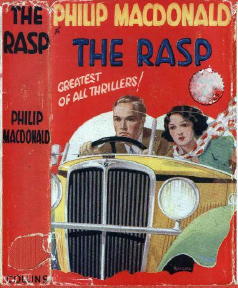
As for the book itself, now that my usual opening digression is over, a nice copy of the British first in jacket will set you back, I am sure, a figure in the low four-digit range. If all you care to do is to find a copy to read, you shouldn’t have to pay more than three or four dollars. Although I have several other editions, the one I just read was the 1984 edition from Vintage Books, and as far as the story’s concerned, there was still plenty of value left.
As a Haycraft-Queen Cornerstone title, there may be more value from historical perspective than there is from a pure story point of view, although I was certainly entertained all of the way through. On the other hand, most readers of contemporary detective fiction will probably not get all that far into it, if they even pick it up in the first place.
This was MacDonald’s first book. It was therefore also obviously the debut of his long-time detective character, Colonel Anthony Gethryn. Gethryn’s career started fast, with ten recorded cases between 1924 and 1933, then one in 1938, followed by a long gap until The List of Adrian Messenger came out in 1960. (There may have been some shorter fiction that appeared in the interim, but during the war years, there was very little if anything that MacDonald produced in the way of mystery fiction.)
To most mystery readers day — to return to the thought I was having a paragraph or so before — a book that was written in 1924 is going to appear as a period piece, stodgy, if not out-and-out primitive. The “rules” of detective fiction were still being formalized — what constituted “fair play” and all that goes with it. This comment does not apply to thrillers, for which authors had other objectives.
Working largely without a “Watson” to bounce his ideas off of, Gethryn notices a lot of things but often keeps them to himself, or at least the significance of them, which helps to explain the necessity of the entirely remarkable 46 page letter that Gethryn writes to the police afterward, laying out in immaculate detail all of his thought processes as he worked his way through the case.
Let me repeat that. Forty-six pages. Is there a denouement longer than this to be found in any other work of detective fiction?
Dead, you may (at last) be interested in knowing, is a noted member of the government. A cabinet minister, in fact, a fellow named John Hoode. The murder weapon is the titular woodworking tool. The place, the study in Hoode’s country residence. The suspects are primarily the few friends, relatives, staff and servants who were also in attendance that fateful evening, as Gethryn soon eliminates The Woman in the case, to his relief, for he has become madly infatuated with her. She is Mrs. Lucia Lemesurier, a widow — her previous husband apparently being eliminated in the movie version — as soon as he meets her it is with an all-but adolescent passion that renders him near speechless in her presence.
Accused by the C.I.D. is Hoode’s secretary, Alan Deacon, to whom all of the evidence seems to point. This includes the most damning: his and only his fingerprints were found on the woodmaking murder weapon. There is a good summation of the facts against Deacon on page 121. Gethryn demurs, however, and reassures the gentleman’s lady friend that all shall be well.
Another detective writer’s creation is mentioned on page 43, where Gethryn declaims somewhat unhappily:
“And I feel as futile as if I were Sherlock Holmes trying to solve a case of Lecoq’s.” He put a hand to his head. “There’s something about this room that’s haunting me! What is the damned thing? Boyd, there’s something wrong about this blasted place, I tell you!”
For the most part, however, Gethryn putters about most happily, this game of investigation invigorating him no end, ending days of malaise after his return from the war (the first one). Most of Chapter Two is a mini-biography of Anthony Ruthven Gethryn, for those who would like to know more, but in essence he is the well-to-do bored genius, who needs the incentive of a murder to be solved to be at ease with himself.
At least that’s his persona in this, his first appearance. Whether, like Ellery Queen, he changed over the years, at the moment I cannot tell you. Perhaps you can tell me.
PostScript: I found another quote that I intended to include, and I didn’t. I can’t find an appropriate place to put it now, without interrupting whatever train of thought I was riding at a particular juncture, so I’ll put it here. What this seems to do is reinforce several of the ideas I was working on, especially toward the end of what I was saying. From pages 111-112, with Gethryn visiting Lucia in her drawing room:
For a moment his eyes closed. Behind the lids there arose a picture of her face — a picture strangely more clear than any given by actual sight.
“You,” said Lucia, “ought to be asleep. Yes, you ought! Not tiring yourself out to make conversation for a hysterical woman that can’t keep her emotions under control.”
“The closing of the eyes,” Anthony said, opening them, “merely indicates that the great detective is what we call thrashing out a knotty problem. He always closes his eyes you know. He couldn’t do anything with ’em open.”
She smiled. “I’m afraid I don’t believe you, you know. I think you’ve simply done so much to-day that you’re simply tired out.”
“Really, I assure you, no. We never sleep until a case is finished. Never.”
PostScript #2. I really do not know what to make of the cover of the paperback edition that I read.
UPDATE [06-02-07] I’ve belatedly decided to include a list of all of the Gethryn novels. UK editions only, but the US titles are given if they were changed. Taken from Crime Fiction IV, by Allen J. Hubin:
* The Rasp (n.) Collins 1924 [England]
* The White Crow (n.) Collins 1928 [England]
* The Link (n.) Collins 1930 [England]
* The Noose (n.) Collins 1930 [London]
* The Choice (n.) Collins 1931 [England] US: The Polferry Riddle
* The Wraith (n.) Collins 1931 [England; 1920]
* The Crime Conductor (n.) Collins 1932 [London]
* The Maze (n.) Collins 1932 [London] US: Persons Unknown
* Rope to Spare (n.) Collins 1932 [England]
* Death on My Left (n.) Collins 1933 [England]
* The Nursemaid Who Disappeared (n.) Collins 1938 [London]
* The List of Adrian Messenger (n.) Jenkins 1960 [London]
Sat 2 Jun 2007
As often happens, a blog entry on one subject will produce one on another, often an author which inspires a comment that generates a lot of research on yet another author, only accidentally related to the first one.
Case in point:
I reviewed the movie Catch Me a Spy not too long ago, a film based on a spy thriller by George Marton. No death date for Marton was known, but some fast research readily came up with one, and a short profile for him soon followed.
A comment left by Juri Nummelin wondered if the Marton’s story, “Play Dirty,” made into a film of the same name, meant that Marton and the pseudonymous “Zeno,” who wrote the novelization of the film, were one and the same man.
The answer, as it turns out, is no, the two are not the same at all. It was John Herrington in England who came up with the answer as to who Zeno was, although (with the advent of the Internet) it does not seem to have been a highly guarded secret.
Taken from a succession of emails from John —
This is a bio from the paperback of one of his books:
Before being commissioned in the field Z was himself a sergeant in the British First Airborne Division. Served with them in North Africa and Central Mediterranean, and at Arnheim – though he managed to escape. For last few months of his service, was deputy Assistant Adjutant General of an area in Southern India.
After the war, he has led an eventful life! Committed murder and jailed for it. Definitely eventful.
Ah, tracked the murder down. According to the Times, on the evening of the 23rd March 1958 Eric Battye, proprietor of the Mackworth Hotel, Swansea, was stabbed to death by one Gerald Theodore Lamarque, aged 46, of no fixed address. (A comment by his daughter on another web page says a ‘crime of passion’).
Found his death. His death is registered in London City in the fourth quarter of 1978, so October sounds correct. Date of birth given as 2nd June 1920, so the age in the murder report appears wrong.
And found his birth. Gerald T. La Marque (mother’s name Norton) registered in West Ham 3rd quarter of 1920. A typo I presume, as his father was Robert Gerald Lamarque, born 1886, married Dorothy C. Norton in 1912. It seems his father lived in West Ham most of his life.
Zeno’s prior entry in Crime Fiction IV, by Allen J. Hubin, previously contained only one title, and as you will see below, next to no other information about him:
ZENO; pseudonym
* Grab (London: Macmillan, 1970, hc) [Africa] Stein, 1970.
A further investigation on my part produced the following partial bibliography for him. It is incomplete, as I suspect that some titles that aren’t so indicated may have been published in the UK in hardcover, most likely by Macmillan.
The Cauldron. Stein & Day, hc, 1967; Dell, pb, 1968. Pan, UK, pb.
“The savage new novel of World War II – by the most knowing, literate and moving writer of our century about war” and “The Author of this extrordinary novel is now serving a life sentance for homicide. He has been in the past a soldier, a sailor and a farmer. He fought with the British 1st Airborne Division at Arnhem. This is the story of a platoon in that ill-fated battle. It makes every other novel of war seem like a tale for children…”
“The Cauldron traces the fortunes of the men of a single pathfinder platoon, from their pre flight briefing in afternoon sunlight on an English airfield to the bitter end nine days later, trapped with the shattered remnants of the parachute brigade in the smoking ruins of Arnhem, The Dutch village that came to be known as the cauldron.”
Winner of an Arthur Koestler prize for prison literature.
Life. Stein & Day, hc, 1968. Macmillan, hc, UK, 1968; Pan, UK, pb, 1970.
The author’s experience in Wormwood Scrubs prison as a ‘lifer.’ “A startling human document and a biting triumph born out of one man’s conscience. A prison book with a difference.”
Play Dirty. Dell, pb, 1969. Pan, UK, pb, 1969. Novelization of the movie of the same title. No hardcover editions.
Led by a young demolition expert, with a callous mass-murderer as his deputy, a bizarre group of killers and perverts — the scum of the Middle East — are sent on a desperate mission behind Rommel’s lines… Hating the Germans a little more than they hate each other, the exploits of these ruthless saboteurs are studded with murder, treachery and heroism as they fight a bitter war — knowing the winner must play dirty.
Grab. Stein & Day, hc, 1970. Macmillan, UK, hc, 1970; Pan, UK, pb, 1972.
Thriller about an ex-MI6 agent hired to collect an Arab in the desert and finding himself pitted against a sinister syndicate called the Greeks.
The Four Sergeants. Atheneum, hc,1977. Pan, UK, pb
World War II fiction: “In the summer of 1943, four platoon sergeants, with precarious orders from their generals, parachute into Sicily to blow up a bridge.” Another citation says: “The 21st Independent Parachute Company included at least 26 Austrian, German, Polish and Czech anti-Nazi Refugees, who volunteered from the Pioneer Corps, using mostly Irish and Scottish Nommes de Guerre — almost all of whom were Jewish. In the novel The Four Sergeants by Zeno, their courage is described as outstanding by the author, who fought with them.”
Of these titles, Play Dirty has been included in Part 15 of the online Addenda to the Revised Crime Fiction IV, just uploaded, but with a hyphen to indicate marginal crime-related content.
Sat 2 Jun 2007
A long obituary for noted journalist and war correspondent Edward S. Behr appeared in yesterday’s New York Times. He died in Paris last Saturday at the age of 81. Among his many other jobs and positions, Mr. Behr was a reporter and editor for Newsweek magazine between 1965 and 1988.
According to the Times, he “covered wars in Algeria, Albania, Congo, Vietnam, Lebanon, and Northern Ireland … wrote about China’s Cultural Revolution … went to Cuba after the 1962 missile crisis. And in 1968 alone he covered the Tet offensive in Vietnam, the student riots in Paris and the Soviet occupation of Prague.”
Author of 19 books, including biographies of Nicolae Ceausescu and Emperor Hirohito of Japan, Mr. Behr began his career in journalism with Reuters in London while earning degrees from Cambridge University in 1951 and 1953.
Of interest to mystery readers, especially those who enjoy spy and suspense fiction, is his one entry in Crime Fiction IV, by Allen J. Hubin:
BEHR, EDWARD (Samuel) (1926-2007)
* Getting Even (Harper, 1980, hc) [Paris] H. Hamilton, 1980. (No paperback editions.)
A bookseller on ABE describes the book this way, most likely taken, at least in part, from a blurb on the cover:
“Espionage novel about a French spy who seeks revenge for the betrayal of his Chinese lover. It was a note left in a supermarket which set everything in motion, a cry for help from a beautiful young secretary in a Western embassy of the Chinese People’s Republic which led to her forcible liberation, a brief but passionate love affair with her liberator, their betrayal, and his intricate and extraordinary revenge. Novel based on two true events — a Chinese diplomat defected from the embassy of the People’s Republic of China in The Hague in 1970 returning voluntarily to China in 1973. Similarly, a Chinese mission official requested political asylum while passing through Orly Airport in May 1971, but was handed back to the Chinese authorities against his will. Beyond these two events, none of the characters or institutions in this book exist.”
Mr. Behr was also the co-screenwriter for Half Moon Street, a film based on Paul Theroux’s Doctor Slaughter (H. Hamilton, UK, hc, 1984; U.S. title: Half Moon Street, Houghton Mifflin), a book also included in CFIV.
The film starred Sigourney Weaver and Michael Caine, with the plot line described on IMDB as follows:
Dr. Lauren Slaughter, a research fellow at the Arab-Anglo Institute in London is utterly frustrated by her job. To supplement her income, she starts moonlighting at the Jasmine Escort Service, where she has more control over men and money than she does at the office. On one of her ‘dates’, Lauren meets the politician Lord Bulbeck who is trying to mediate a peace accord between the Arabs and Israelis. Bulbeck falls in love with his escort, and unwittingly, Lauren becomes a pawn in some very dirty politics.
A review in the New York Times says in part:
As directed and co-written by Bob Swaim,
Half Moon Street displays an odd eagerness to stay within the bounds of familiar genres, even where none exist. A change that takes the sting out of Mr. Theroux’s ending, and a bit of miscasting designed to drum up an impossible romance, are only two of the unhelpful modifications that have been made. And as played by Sigourney Weaver, Lauren becomes a good deal less complex. She merely seems arrogant, patronizing and unbearably smug.
Mr. Behr also wrote a history of Prohibition in the US and large illustrated books about the Broadway musicals Miss Saigon and Les Misérables.
« Previous Page
